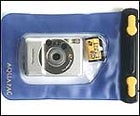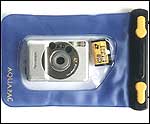It’s certainly true that digital cameras have far fewer moving parts than film-based cameras—and in particular, no gaping hatch in back where the film goes, along with heaven knows what sort of grit and sand to scratch film or jam gears. So most ANY digital camera is going to be relatively more resistant to sand than its film predecessors.
 Aqua-410
Aqua-410
My current digital camera—the photographic tech-geek in my beloved collection of classic film cameras—is a Canon S410 PowerShot ($290 street price, www.canonusa.com), which is a wonderful little four-megapixel camera with a 3x zoom and easy-to-use interface. It has very few crannies where sand can work its way in, and while I wouldn’t roll it around in dry sand, I certainly wouldn’t hesitate to take it to the beach. In fact, I do most every day, when I walk my beagles.
In general, though, while a camera such as the S410 is sand-resistant, it’s not technically sandproof. And I doubt anything is, even the Olympus Stylus MP 500 ($340 street price, www.olympusamerica.com), a camera that’s billed as “weather-resistant.” However, that tag does mean it’s built with special seals to keep out water and hopefully deter other debris, making it a good choice for rough use.
But there’s a simpler solution. Buy any camera you wish, then spend $30 more and get an Aquapac Aqua-410 (www.aquapac.net). It’s a flexible waterproof case that will hold most any small digital camera, and effectively protect it against dust and sand as well as a spill into the drink. A great thing, really, and an essential accessory for anyone whose camera may find itself in harm’s way.
More cameras reviewed in ���ϳԹ���‘s
.


